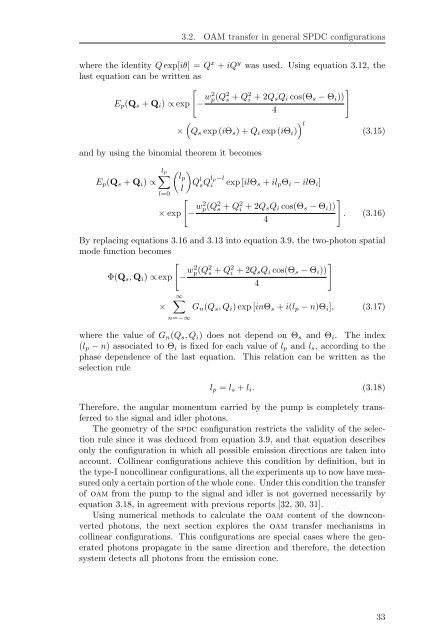Spatial Characterization Of Two-Photon States - GAP-Optique
Spatial Characterization Of Two-Photon States - GAP-Optique
Spatial Characterization Of Two-Photon States - GAP-Optique
You also want an ePaper? Increase the reach of your titles
YUMPU automatically turns print PDFs into web optimized ePapers that Google loves.
3.2. OAM transfer in general SPDC configurations<br />
where the identity Q exp[iθ] = Q x + iQ y was used. Using equation 3.12, the<br />
last equation can be written as<br />
<br />
Ep(Qs + Qi) ∝ exp − w2 p(Q2 s + Q2 i + 2QsQi<br />
<br />
cos(Θs − Θi))<br />
4<br />
<br />
l × Qs exp (iΘs) + Qi exp (iΘi)<br />
and by using the binomial theorem it becomes<br />
(3.15)<br />
lp<br />
<br />
lp<br />
Ep(Qs + Qi) ∝ Q<br />
l<br />
l=0<br />
l sQ lp−l<br />
i exp [ilΘs + ilpΘi − ilΘi]<br />
<br />
× exp − w2 p(Q2 s + Q2 i + 2QsQi<br />
<br />
cos(Θs − Θi))<br />
. (3.16)<br />
4<br />
By replacing equations 3.16 and 3.13 into equation 3.9, the two-photon spatial<br />
mode function becomes<br />
<br />
Φ(Qs, Qi) ∝ exp − w2 p(Q2 s + Q2 i + 2QsQi<br />
<br />
cos(Θs − Θi))<br />
4<br />
∞<br />
× Gn(Qs, Qi) exp [inΘs + i(lp − n)Θi], (3.17)<br />
n=−∞<br />
where the value of Gn(Qs, Qi) does not depend on Θs and Θi. The index<br />
(lp − n) associated to Θi is fixed for each value of lp and ls, according to the<br />
phase dependence of the last equation. This relation can be written as the<br />
selection rule<br />
lp = ls + li. (3.18)<br />
Therefore, the angular momentum carried by the pump is completely transferred<br />
to the signal and idler photons.<br />
The geometry of the spdc configuration restricts the validity of the selection<br />
rule since it was deduced from equation 3.9, and that equation describes<br />
only the configuration in which all possible emission directions are taken into<br />
account. Collinear configurations achieve this condition by definition, but in<br />
the type-I noncollinear configurations, all the experiments up to now have measured<br />
only a certain portion of the whole cone. Under this condition the transfer<br />
of oam from the pump to the signal and idler is not governed necessarily by<br />
equation 3.18, in agreement with previous reports [32, 30, 31].<br />
Using numerical methods to calculate the oam content of the downconverted<br />
photons, the next section explores the oam transfer mechanisms in<br />
collinear configurations. This configurations are special cases where the generated<br />
photons propagate in the same direction and therefore, the detection<br />
system detects all photons from the emission cone.<br />
33



